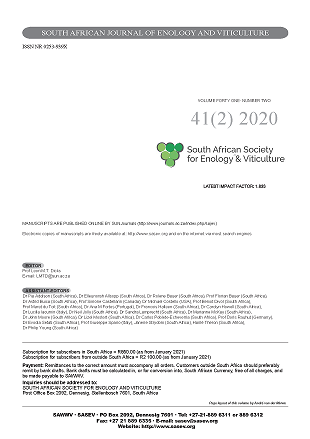Is There a Link Between Coffee Aroma and the Level of Furanmethanethiol (FMT) in Pinotage Wines
DOI:
https://doi.org/10.21548/41-2-4224Abstract
Over the years, Pinotage has found its way into the South African and international market. Producers have used the flavour potential of this “original” South African grape to produce different wine styles, one of them being the so-called “coffee-style Pinotage”. The current study aims to explain the impact of furanmethanethiol (FMT) on the characteristic coffee aroma of these coffee-style wines. Chemical and sensory evaluation, as well as data mining of the technical information available, was performed. Not all wines marketed as “coffee Pinotage” showed a high “coffee” rating. However, the results showed a good correlation between the aroma perception and FMT concentrations (R2 = 0.81). However, RV coefficients were low when comparing the coffee rating with the information provided on both the front and the back label, which shows that, in some cases, the use of the “coffee Pinotage” term was rather part of the marketing strategy.
Downloads
References
Brand, J., Panzeri, V. & Buica, A., 2020. Wine Quality Drivers : A Case Study on South African Chenin Blanc and Pinotage Wines. Foods 1–17.
Chatonnet, P., Bonnet, S., Boutou, S. & Labadie, M.D., 2004. Identification and Responsibility of 2,4,6-Tribromoanisole in Musty, Corked Odors in Wine. J. Agric. Food Chem. 52(5), 1255–1262.
Fernández De Simón, B., Cadahía, E., Álamo, M. & Nevares, I., 2010. Analytica Chimica Acta Effect of size , seasoning and toasting in the volatile compounds in toasted oak wood and in a red wine treated with them. Anal. Chim. Acta 660 211–220.
Ferreira, V., 2010. Volatile aroma compounds and wine sensory attributes. In: Manag. Wine Qual. Elsevier 3–28.
Ferreira, V., Sáenz-Navajas, M.-P.P., Campo, E., Herrero, P., de la Fuente, A., Fernández-Zurbano, P., Fuente, A. de la & Fernández-Zurbano, P., 2015. Sensory interactions between six common aroma vectors explain four main red wine aroma nuances. Food Chem. 199 447–456.
Fourie, B.A., 2005. The influence of different barrels and oak derived products on the colour evolution and quality of red wines. Stellenbosch University.
Garrido‐Bañuelos, G., Panzeri, V., Brand, J. & Buica, A., 2020. Evaluation of sensory effects of thiols in red wines by projective mapping using multifactorial analysis and correspondence analysis. J. Sens. Stud. (May, 4).
Mafata, M., Stander, M., Thomachot, B. & Buica, A., 2018. Measuring Thiols in Single Cultivar South African Red Wines Using 4,4-Dithiodipyridine (DTDP) Derivatization and Ultraperformance Convergence Chromatography-Tandem Mass Spectrometry. Foods 7(9), 138.
Marais, J. & Jolly, N., 2004. Pinotage Aroma Wheel. WineLand 113–114.
Mayr, C.M., Capone, D.L., Pardon, K.H., Black, C.A., Pomeroy, D. & Francis, I.L., 2015. Quantitative Analysis by GC-MS/MS of 18 Aroma Compounds Related to Oxidative Off-Flavor in Wines. J. Agric. Food Chem. 63(13), 3394–3401.
McKay, M. & Buica, A., 2020. Factors Influencing Olfactory Perception of Selected Off-flavour- causing Compounds in Red Wine - A Review. South African J. Enol. Vitic. 41(1), 56–71.
Naudé, Y. & Rohwer, E.R., 2013. Investigating the coffee flavour in South African Pinotage wine using novel offline olfactometry and comprehensive gas chromatography with time of flight mass. J. Chromatogr. A 1271(1), 176–180.
Ruiz, J., Kiene, F., Belda, I., Fracassetti, D., Marquina, D., Navascués, E., Calderón, F., Benito, A., Rauhut, D., Santos, A. & Benito, S., 2019. Effects on varietal aromas during wine making: a review of the impact of varietal aromas on the flavor of wine. Appl. Microbiol. Biotechnol. 103(18), 7425–7450.
Siebert, T.E., Wood, C., Elsey, G.M. & Pollnitz, A.P., 2008. Determination of Rotundone , the Pepper Aroma Impact Compound , in Grapes and Wine. J. Agric. Food Chem. 56 3745–3748.
Smith, P.A., McRae, J.M. & Bindon, K.A., 2015. Impact of winemaking practices on the concentration and composition of tannins in red wine. Aust. J. Grape Wine Res. 21 601–614.
Stamatopoulos, P., Frérot, E. & Darriet, P., 2015. Evidence for Perceptual Interaction Phenomena To Interpret Typical Nuances of “ Overripe ” Fruity Aroma in Bordeaux Dessert Wines. In: Chem. Sens. Informatics Food Meas. Anal. Integr. 87–101.
Tominaga, T., Blanchard, L., Darriet, P. & Dubourdieu, D., 2000. A Powerful Aromatic Volatile Thiol, 2-Furanmethanethiol, Exhibiting Roast Coffee Aroma in Wines Made from Several Vitis v inifera Grape Varieties. J. Agric. Food Chem. 48(5), 1799–1802.
Vannevel, M., 2015. Marketing wines to South African Millennials: The effect of expert opinions on the perceived quality of Pinotage wines. Stellenbosch Univ.
Weldegergis, B.T., de Villiers, A. & Crouch, A.M., 2011. Chemometric investigation of the volatile content of young South African wines. Food Chem. 128(4), 1100–1109.
Downloads
Published
Issue
Section
License
A copyright form will be e-mailed to the corresponding author when the manuscript has been accepted for publication.
In principle, the Author agrees to the following when he/she signes the copyright agreement:
I hereby assign to the SOUTH AFRICAN SOCIETY FOR ENOLOGY AND VITICULTURE (SASEV) the copyright of the text, tables, figures, supplementary material, illustrations and other information (the Material) submitted with the manuscript to be published in SOUTH AFRICAN JOURNAL OF ENOLOGY AND VITICULTURE (SAJEV) (the "Article"). The copyright becomes effective from the date the Article has been accepted for publication in SAJEV.
This is an open access journal, and the authors and journal should be properly acknowledged, when works are cited.
Author's may use the publishers version for teaching purposes, in books, theses, dissertations, conferences and conference papers.
A copy of the authors' publishers version may also be hosted on the following websites:
- Non-commercial personal webpage or blog.
- Institutional webpage.
- Authors Institutional Repository.
The following notice should accompany such a posting on the website: This is an electronic version of an article published in SAJEV, Volume XXX, number XXX, pages XXX - XXX, DOI. Authors should also supply a hyperlink to the original paper or indicate where the original paper (www.journals.ac.za/index.php/sajev/) may be found.
Authors publishers version, affiliated with the Stellenbosch University will be automatically deposited in the University's Institutional Repository SUNScholar.
Articles as a whole, may not be re-published with another journal.
The following license applies:
Attribution CC BY-NC-ND 4.0

